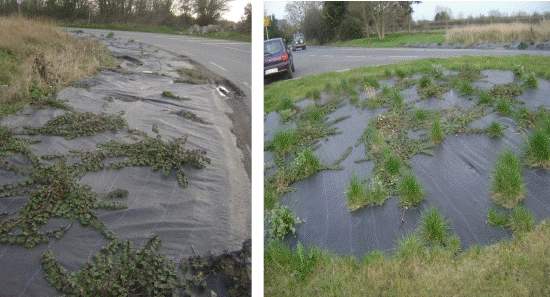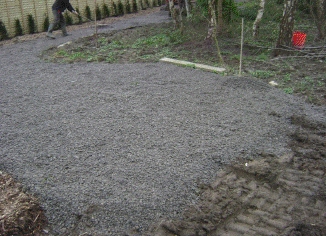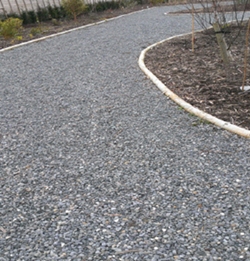I hate landscape fabric. I hate putting it down, I hate cutting and planting into it and I hate having to remove it, particularly when it gets covered up with any depth of material. I’ve blunted many a Stanley knife and secateurs trying to get it out, it is almost indestructible. No doubt in the far future, archaeologists will curse this plastic material that keeps appearing in their digs. It has its uses but it is overused by professional and amateur alike.
There will never be a perpetual motion machine and there will never be a garden product that will give us freedom from weeds, and weeding. Landscape fabric is a help in our never ending battle with weeds, but only a help. Plant and walk away gardening is never an option. Nature, like rust, never sleeps. We get customers in the garden centre that are of the firm belief that once they use this product their weeding days are over.
Mypex was the first major brand of landscape fabric on the market and is the term often used for it, like Hoover for vacuum cleaner. There is also a cheaper, easier torn fabric. It’s important to know the limitations of these materials so they can just be used in situations where they give real benefits.

Ground cover fabric with gravel and scutch
It is no good on strong slopes as the covering material will slide away over time, leaving the exposed membrane as an eye sore. The same goes for ground with lots of humps and bumps, these have to be flattened out first, no shortcut there. Scutch grass (Agropyron repens) and other perennial weeds, particularly when heavily infested, can come through landscape fabric, and once through, can make use of the lack of competition. So normal garden practices when it comes to perennial weeds cannot be short circuited, in other words, clean up the ground first.

Two of the worst examples of public landscaping I have ever seen (outside Drogheda)
Even where the fabric has a good deal of aggregate over it, sufficient to suppress most underlying weeds, there is still a problem at the places cut out for the shrubs. I’ve noticed that it is often from these weak points that plants like scutch and creeping buttercup (Ranunculus repens) get their foothold and quickly moves through the rest of the planting if not stopped.
Landscape fabric will prevent normal improvement in soil by acting as a barrier to air and organic matter, so soils should be in good condition before it is used; this is less a problem on drier soils. I don’t like its use under bark or other organic material, but sometimes needs must. It is not particularly suitable for use with perennials or other plants that grow outwards from the root as it restricts them. The same goes for plants that root from the stems such as vinca and common ivy (Hedra helix) as they find it difficult to establish into the membrane.
Landscape fabrics are most suitable for use with gravel, funny enough, weeds actually germinate in gravel easier than in bark. It also cuts way down on the amount of gravel needed, particularly important when using the more expensive kinds.

Gravel and soil and lots of toil.

One year later the gravel has settled in nicely
We put in some paths last year (see2 photos above) using 14ml grey gravel (often called ‘pebble’ in Ireland) and it went directly onto the soil, which was really muck at the time. We didn’t use membrane, as the gravel wouldn’t bed in properly and bind with the soil. We also didn’t bother putting in a hardcore base as there would just be light foot traffic. More importantly, if a hardcore base is not properly blinded with rock dust or similar, some of the bigger pieces of stone will make their way to the surface. A rake will always drag up big stuff, and gravel should always be raked!
Rough hardcore pieces mixing with the more ornamental gravel can look untidy and be an eye sore, particularly if it is a different colour. In our part of the country, hardcore is usually grey crushed limestone, and the decorative stone on top is often a warm brown from the opposite end of the spectrum, not good together. I saw this charming combination on the gravel path in front of Farmleigh House. We used a lot of gravel as it was cheap by the full truck load and its compaction was greatly helped by our customers walking on it. The initial surge of weeds was dealt with complements of Mr. Monsanto.

“John has a diploma in Horticulture from the National Botanic Gardens, a degree in Botany from Trinity College and a diploma in Tree Craftsmanship from Merrist Wood College in Surrey. He worked in the nurseries of north Germany where he got his interest in craft gardening. He is the owner of Ratoath Garden Centre, whose slogan “mad about plants”, is not far from the truth!”
Source: HortiTrends News Room





